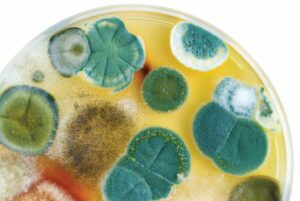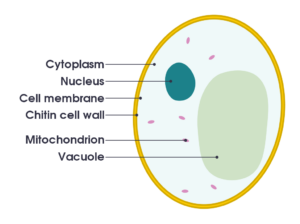Fungus (plural: Fungi) cannot photosynthesize so they can be considered heterotrophs.
Fungi unlike algae do not have any photosensitive pigments so they cannot produce food via photosynthesis. Instead, they obtain their nutrition from other sources that is what is said to be heterotrophic.
So the question arises are fungi heterotrophs? Technically they cannot eat like animals, instead, they obtain their nutrition from dead and decaying matter. This is the reason we can find mushrooms growing on dead, decaying matter with ample humidity. This includes the forest floor, on tree trunks and sometimes in the corners of our homes during monsoon.
All about kingdom Fungi:
- Fungi are a separate kingdom in the eukaryote organism structure just like plants and animals. Fungi include all types of yeasts, molds and mushrooms.
- Fungi like animals cannot produce their food, so they have heterotrophic nutrition i.e they depend on other organisms as a source of food.
- Fungi are what we call saprophytic in nature i.e. they get their nutrition from dead and decaying organic matter. They typically do so by secreting their digestive juices into the environment they grow in, and absorbing all the nutrients they can get their hands on.
- So they can live in a symbiotic relationship with other plants or live as parasitic organisms altogether.
- They have cell walls made of chitin a type of hetero-poly glucan.
- Fungi generally reproduce with the help of spores i.e. asexually. These spores can survive the harshest condition.
- For a better survival rate, a fungus can release several thousand of these at once.
- Fungi have special features to facilitate the release of spores. For example mushrooms their gills to store and release their spores into the air and medium.
- Fungi are the molds that appear on spoiled food or leather goods. They can also cause diseases like athlete’s foot.
- There are a lot of beneficial fungi as well- including all the mushrooms that we consume and yeast used in cooking, baking and alcohol brewing.
- Penicillin the first antibiotic was extracted from a fungus called Penicillium.
All fungi are heterotrophic?
Since fungi are unable to synthesize their own food so they have a heterotrophic mode of nutrition.
Plants and algae are called autotrophs as they synthesize their main food source in the form of glucose. Since fungi are unable to perform this function they are called heterotrophs.
Plants and algae are organisms that can biosynthesize their food from inorganic matter- gases, water and sunlight. So they are conventionally termed as autotrophs. All other organisms that depend on other plants and animals for their nutritional needs are called as heterotrophs.

Image: Wikipedia
Since no fungi discovered to date have any photosynthesizing pigment in them, hence it can be considered that kingdom fungi consist of heterotrophs only.
How are fungi heterotrophs?
Since fungi are unable to synthesize food and absorb it from organic matter in their environment they are heterotrophs.
The word heterotroph comes from Greek words “hetero” meaning other and “troph” meaning nutrition. This refers to organisms that require other organic sources of nutrition as they are unable to synthesize it themselves.
Fungi can have 3 nutrition sources- saprophytic, parasitic or symbiotic. Saprophytic meaning that they depend on dead and decaying organic matter to survive, This pertains to mould and mushrooms that grow on the forest floor or dead matter.
Parasitic fungi refer to those that depend on living organisms for nutrition and in turn also harm their host. This includes fungi that cause diseases among plants animals and humans. For example, fungi cause diseases like leaf spots and powdery mildew in plants whereas they can cause athlete’s foot and ringworm. All these are highly contagious.
Some fungi can also have symbiotic relations with plants. In these cases, the fungi and the plants both receive the benefits from this mutually beneficial relationship. Mycorrhiza is the homes these fungi make in the root systems or rhizospheres of these plants. They form colonies and supply water and minerals to their hosts and receive glucose molecules as repayment.
Fungi heterotrophic characteristics:
Saprophytic fungi feed on dead and decaying organic matter. They do so by releasing their digestive juices into their environment and sucking up all the digested organic matter using their roots or hyphae. Hence they also work as ecological decomposers.
Fungi grow from the tips of the nodes of the hyphae and the organism itself as parts called mycelia to absorb the digested from matter. The hyphae run under the forest floor or their growing medium like plant runners and spout out mushrooms from every node.
There are fungi like the baker’s yeast(Saccharomyces cerevisiae) that are unicellular and very simple in structure. They usually require a warm and humid environment to grow and activate in. They can obtain all the nutrition they require from something as simple as a sugar solution.

They do not have any special structures, taking up simple monosaccharides and disaccharides by diffusion through their cell wall.
Parasitic fungi can absorb food through their hyphae themselves that they stick against the cells of the host organism. On the other hand, some of them produce special structures called haustoria just for this purpose.
Haustoria are specialized structures that extend and pierce into the host cell itself to absorb nutrition through them.
Conclusion:
Historically fungi once belonged to kingdom Plantae but were segregated as they cannot photosynthesize. They could not be considered plants due to the absence of pigments. But they couldn’t be considered as animals either due to vegetation and spore inducing asexual propagation methods and the presence of a cell wall.
So they were separated into a whole different kingdom. And since they could not photosynthesize their own food they developed ways to obtain nutrition from the environment themselves. So they became heterotrophs i.e. they depended on other organisms whether living or dead to obtain sustenance for themselves.
Humans too used this feature to use them commercially, for example, the Baker’s yeast used in baking and alcohol brewing. They simply obtain their required from the sugars water in bread doughs to produce carbon dioxide that makes the dough rise. This released CO2 is what gives cakes and bread their fluffy texture.
I breweries yeast obtains sugars from the fruit juices and produce ethyl alcohol and carbon dioxide. This is what in different concentrations gives rise to wine and beer. Hence the heterotrophic nature of fungi can be essentially useful as well.
Also Read:
- Zygote 2
- Moss examples
- Is adenine an amino acid
- Chloroplast growth
- Is dna polymerase an enzyme
- How are nucleotides produced
- Lichen examples
- Iron bacteria examples
- Aerobic respiration stages
- Exotic species examples

I am Trisha Dey, a postgraduate in Bioinformatics. I pursued my graduate degree in Biochemistry. I love reading .I also have a passion for learning new languages.
Let’s connect through linked in: